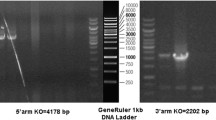Abstract
PD1 is a novel protein particularly expressed at the testicular level. The relative cDNA sequences were cloned from human and rat testis libraries revealing an open reading frame for a protein of 520 and 511 amino acids respectively. The human PD1 amino acid sequence shows 85% identity with rat sequence suggesting that PD1 gene has been highly conserved during mammalian evolution. Immunohistochemical analysis showed that this protein is detected in the tubular compartment of the testis and, in particular, in the cytoplasm of the Sertoli cells. PD1 expression is not constitutive but seems to be under the influence of neighboring spermatogenic cells as demonstrated by its reduction in hypospermatogenesis with respect to normal spermatogenesis and a further reduction in Sertoli cell-only syndrome. During testicular development in the rat (from 2 to 45 days of age) the PD1 mRNA level became detectable at 14 days and then increased steadly with an advancement of age. These findings suggest that PD1 may play a role in the regulation of spermatogenesis and may be a potential candidate gene for defects of male fertility.
Similar content being viewed by others
References
Lahn B.T., Page D.C. Functional coherence of the human Y chromosome. Science 1997, 278: 675–680.
Cook H.J., Hargreave T., Elliott D.J. Understanding the genes involved in spermatogenesis: a progress report. Fertil. Steril. 1998, 69: 989–995.
Graziotto R., Foresta C., Scannapieco P., Zeilante P., Russo A., Negro A., Salmaso R., Onisto M. cDNA cloning and characterization of PD1: a novel human testicular protein with different expressions in various testiculopathies. Exp. Cell Res. 1999, 248: 620–626.
Ma K., Inglis J.D., Sharkey A., Bickmore W.A., Hill R.E., Prosser E.J., Speed R.M., Thomson E.J., Jobling M., Taylor K., Wolfe J., Cooke H.J., Hargreave T.B., Chandley A.C. A Y chromosome gene family with RNA-binding protein homology: candidates for the azoospermia factor AZF controlling human spermatogenesis. Cell 1993, 75: 1287–1295.
Foresta C., Ferlin A., Garolla A., Moro E., Pistorello M., Barbaux S., Rossato M. High frequency of well-defined Y chromosome deletions in idiopathic Sertoli cell-only syndrome. Hum. Rep. 1998, 13: 302–307.
Taenasky H., Gill D., Murthy S., Shao X. Demetrick D.J., van der Hoorn F.A. A novel testis-specific gene, SPAG4, whose product interacts specifically with outer dense fiber protein ODF27, maps to human chromosome 20q11.2. Cytogenet. Cell Genet. 1998, 81: 65–67.
Maruyama O., Nishimori H., Katagiri T., Miki Y., Ueno A., Nakamura Y. Cloning of TCFL5 encoding a novel human basic helixloop-helix motif protein that is specifically expressed in primary spermatocytes at the pachytene stage. Cytogenet. Cell Genet. 1998, 82: 41–45.
Altschul S.F., Madden T.L., Schäffer A.A., Zhang J., Zhang Z., Miller W., Lipman D.J. Gapped BLAST and PSI-BLAST: a new generation of protein database search programs. Nucleic Acids Res. 1997, 25: 3389–3402.
Clermont Y., Perey B. Quantitative study of the cell population of the seminiferous tubules in immature rats. Am. J. Anat. 1957, 100: 241–267.
Pineau C., Sharpe R.M., Saunders P.T., Gerard N., Jegou B. Regulation of Sertoli cell inhibin production and of inhibin alpha-subunit mRNA levels by specific germ cell types. Mol. Cell Endocrinol. 1990, 72: 13–22.
Pinon-Lataillade G., Velez de la Calle J.F., Viguier-Martinez M.C., Garnier D.H., Folliot R., Maas J., Jegou B. Influence of germ cells upon Sertoli cells during continuous low-dose rate gamma-irradiation of adult rats. Mol. Cell Endocrinol. 1988, 58: 51–63.
Author information
Authors and Affiliations
Rights and permissions
About this article
Cite this article
Onisto, M., Graziotto, R., Scannapieco, P. et al. A novel gene (PD1) with a potential role on rat spermatogenesis. J Endocrinol Invest 23, 605–608 (2000). https://doi.org/10.1007/BF03343783
Published:
Issue Date:
DOI: https://doi.org/10.1007/BF03343783




